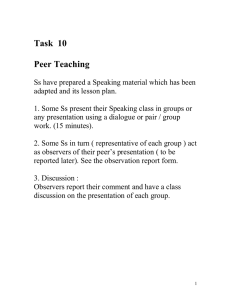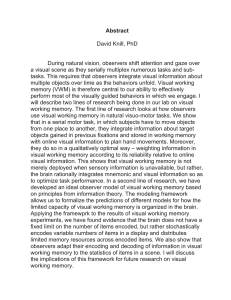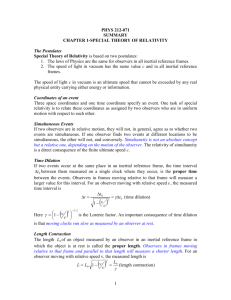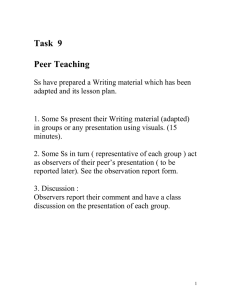Special Relativity Summary/Review
advertisement
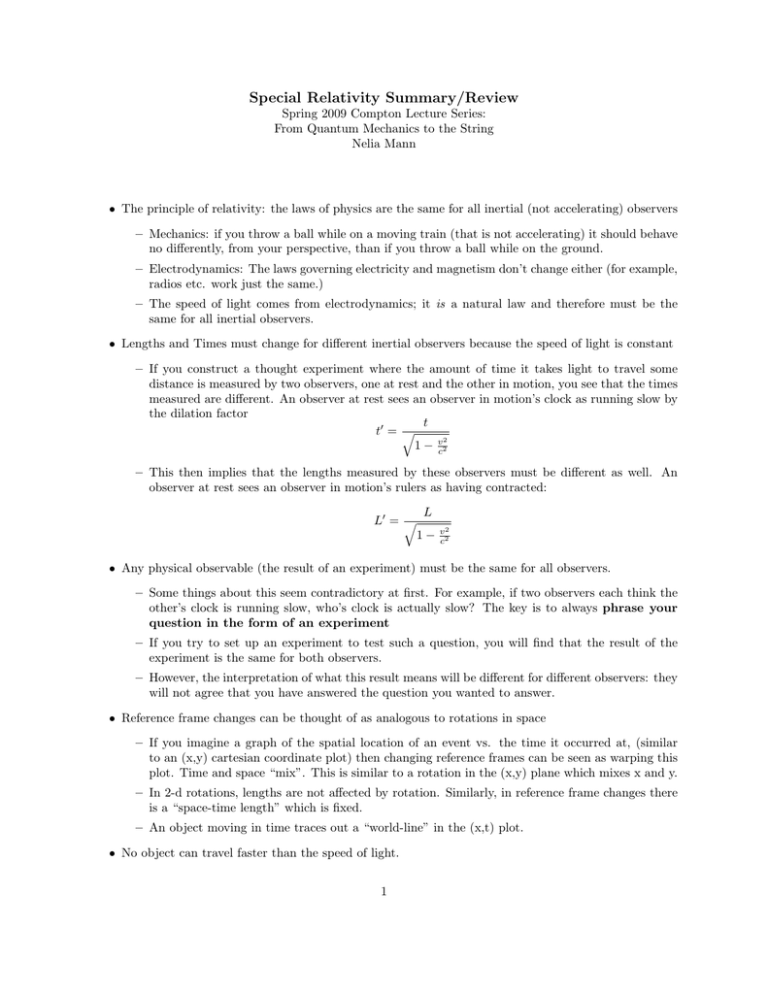
Special Relativity Summary/Review Spring 2009 Compton Lecture Series: From Quantum Mechanics to the String Nelia Mann • The principle of relativity: the laws of physics are the same for all inertial (not accelerating) observers – Mechanics: if you throw a ball while on a moving train (that is not accelerating) it should behave no differently, from your perspective, than if you throw a ball while on the ground. – Electrodynamics: The laws governing electricity and magnetism don’t change either (for example, radios etc. work just the same.) – The speed of light comes from electrodynamics; it is a natural law and therefore must be the same for all inertial observers. • Lengths and Times must change for different inertial observers because the speed of light is constant – If you construct a thought experiment where the amount of time it takes light to travel some distance is measured by two observers, one at rest and the other in motion, you see that the times measured are different. An observer at rest sees an observer in motion’s clock as running slow by the dilation factor t t0 = q 2 1 − vc2 – This then implies that the lengths measured by these observers must be different as well. An observer at rest sees an observer in motion’s rulers as having contracted: L0 = q L 1− v2 c2 • Any physical observable (the result of an experiment) must be the same for all observers. – Some things about this seem contradictory at first. For example, if two observers each think the other’s clock is running slow, who’s clock is actually slow? The key is to always phrase your question in the form of an experiment – If you try to set up an experiment to test such a question, you will find that the result of the experiment is the same for both observers. – However, the interpretation of what this result means will be different for different observers: they will not agree that you have answered the question you wanted to answer. • Reference frame changes can be thought of as analogous to rotations in space – If you imagine a graph of the spatial location of an event vs. the time it occurred at, (similar to an (x,y) cartesian coordinate plot) then changing reference frames can be seen as warping this plot. Time and space “mix”. This is similar to a rotation in the (x,y) plane which mixes x and y. – In 2-d rotations, lengths are not affected by rotation. Similarly, in reference frame changes there is a “space-time length” which is fixed. – An object moving in time traces out a “world-line” in the (x,t) plot. • No object can travel faster than the speed of light. 1 – The time dilation experiment stops making sense if one of the observers can travel faster than the speed of light. – The mathematical factor breaks down and generates an imaginary number for speeds greater than the speed of light – When you perform the “space-time rotation” on the world-line of an object, it never obtains speeds greater than the speed of light. • Mass is a form of energy. – Energy is conserved, it consists of kinetic energy (associated with motion) and potential energy. – The equation governing kinetic energy must be altered because of special relativity. It becomes mc2 E=q 2 1 − vc2 – This energy approaches infinity as v approaches c (it requires an infinite amount of energy to get a massive object moving at the speed of light), but has a finite minimum value when v = 0: E0 = mc2 . This is energy associated to the mass of the object. – Mass is not separately conserved. It is a form of energy and can therefore be converted into other forms of energy. – The mass of a set of objects together is not the mass of each object separately. It is related to the total energy, which comes from the individual objects, their motions with respect to each other, and the forces between them. – We can define the mass of an object as it’s energy when it is at rest and isolated from all external forces. • The speed of light sets the scale of relativistic effects – If we could change the speed of light to set it to be infinitely large, we could get rid of special relativity – time dilation and length contraction would completely disappear, space-time would separate again into time and space, energy would separate into a constant plus classical kinetic energy, and mass and energy would be separately conserved. – So long as your speed is small compared to c, this is effectively true: the world obeys classical physics. Once v ∼ c, special relativistic effects become important. 2

